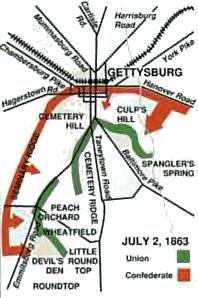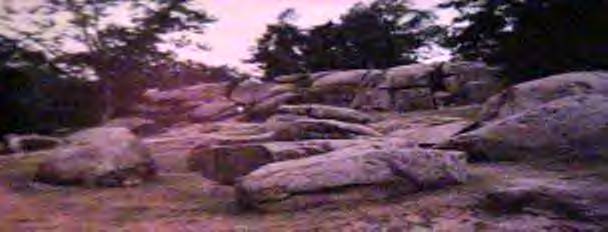|
Visitor Center Union Army Confederate Army Copse of Trees Devil's Den Little Round Top East Calvary Field Big Round Top Spanglers Spring Triangle Field The Peach Orchard The "Bloody" Wheatfield The National Tower Culp's Hill Eternal Light Peace Memorial Reynold's Woods Benner's Hill Pickett's Charge National Cemetery and Evergreen Cemetery Battle in the Town McPherson's Ridge Railroad Cut 
Homes on the Battlefield 
Re-enactors Credits Links Lodging Mailing List Other Battles of The Civil War |
The area just to west west of Little Round Top made of of Large Diabase bolders created millons of years ago from volcanic activity.....This group of Large Bolders that we know as "Devils Den" has a long and very interesting History.We will not only examine what its role was during the battle of Gettysburg but a brief history of the area in general Sitting in a rocky vally on the west side of Little Round Top is the area we know today as "Devil's Den. Over 150 million years in age this area of large boulders was formed by the activity of glaciers during the ice age. The igneous rock was forced up through the earth during the ice age. The area known as "The Gettysburg Sill is about Forty miles Long and nearly 2000 feet thick. It can be seen quite easily by flying over in an airplane or helicopter.This greystone and shale formation is prone to erosion and has been eroding for thousands of years.The rocks are sensitive to heat and cold,wind and rain,snow and ice. It is very possible that the ground in this area was host to another struggle long before the Civil War. Given the nature of the ground with its natural defenses and cracks and crevices it is only understandable that this "Hallowed Ground" is actually good ground for a battle.Many artifacts including arrowheads of different size,tomahawks and other relics have long been storied to have been found on this rocky ridge of the Gettysburg Sill.An old story sometimes heard is that "Devils Den" was the place of a massive Indian Battle of two tribes fighting over the "Big Rocks" because it was once a pyramid type structure that was deystroyed by natural forces. Though unlikely it is odd that you can even to this day walk in and around and through these rocks. Many caverns and tunnels are accesible to small adults and children. In fact it has become a place for children to climb and play through the rocks.
On July Second, James Smith commanding the 4th NY Battery put his men at Devils Den. The Confederates attacked Smith's men in the Devils Den from three positions all at one time.The area was not favorable to either side. The large rocks of 20 feet or more was a horrible place for a battle. With shot and shell racing in around and over the rocks, many troops were killed as a result of scrapnel from these projectiles bopuncing off the boulders.As in many places during the Civil War where the ground was less than favorable,men were thrown into confusion. The battle in this area would switch back and forth several times. Smith placed four of his guns in the vicinity of Trangular Field where they fought off Confederate forces, both infantry and artillery. The artillery commanded by Brigadeer General Henry L. Benning made life hell for Smiths artillerymen. Smith then would turn his attention to the infantry which was quickly advancing up the triangular field toward the Devil's Den. The 15th Georgia and 1st Texas made repeated assults on the heights slowly but surely wearing down the union defenders.For over two hours this desparate assualt and defence would rage in the area until the 1st Texas would finally break through and capture the three of Smiths guns.The 44th Georgia would then pass over the den and make thier way through the gourge next to Little Round Top. The 6th New Jersey and 40th Ny would take on these alabamians and another bloody drawn out struggle would take place in the Valley of Death."
Back and Forth the battle would rage until the Union defenders were forced to retreat. Devil's Den would be captured by the Confederates and they would use it as a sharpshooters pen to pick off Union Defenders on Little Round Top and the surrounding area.Though the Confederates would take the Den they would fail in thier attemt to secure the heights of Little and Big Round Top.As night approached the confederacy would draw up plans for a massive attack on the middle of the Union line on July 3rd and the Den area would take a back seat.

Panoramic View of the "Devils Den" November 11 1863(Click to Enlarge)
 Panoramic View of the "Devils Den" Feb 2001(Click to Enlarge)
What are people saying about This site! "This has got to be the greatest Gettysburg website i have ever seen!!!"William Matthews--Glassboro,NJ "Wow im impressed--Riverside,CA. "My favorite page! "Mike Torrez--Mexico
Copyright © 2001-2005,Gettysburg Battlefield Online
|














